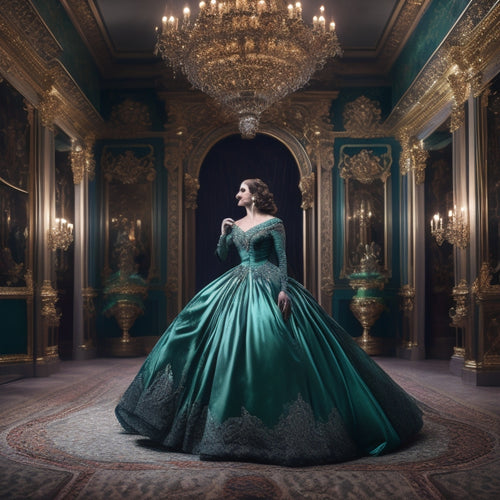
Discover the Art of Dance Across Cultures
Share
Dance is a universal language that transcends cultural boundaries, with diverse styles and traditions reflecting the unique cultural, historical, and social contexts of communities around the world. From traditional performances like Irish Dancing and Kuchipudi to fusion styles like Lyrical Dance, each style showcases cultural heritage and identity. Understanding the cultural roots of dance is essential for appreciating its nuances, as it reflects values, traditions, and practices of a community. As we explore dance traditions, we unravel the richness and diversity of artistic expression. There's more to uncover beyond the allure of this captivating art form.
Key Takeaways
• Dance styles across cultures reflect unique cultural heritage, values, and traditions, showcasing diversity in artistic expression.
• Understanding cultural roots is essential to appreciate nuances in dance styles, such as Irish Dancing and Kuchipudi.
• Fusion styles like Lyrical Dance blend different techniques, demonstrating dance's ability to transcend cultural boundaries.
• Traditional dance performances, like Ukrainian Dance and the Waltz, inspire audiences worldwide with their cultural richness.
• Exploring dance traditions offers insights into cultural identity, historical context, and social practices that shape artistic expression.
Dances Across the Globe
Across the globe, diverse cultures have cultivated unique dance styles, each with its distinct techniques, rhythms, and meanings, weaving a rich tapestry of expression and storytelling.
Traditional performances, such as Irish Dancing and Kuchipudi, showcase the cultural heritage of their respective nations. Global dance influences have also led to the creation of fusion styles, like Lyrical Dance, which blends Ballet, Jazz, and Modern dance.
The beauty of dance lies in its ability to transcend cultural boundaries, allowing people to connect and appreciate the diversity of traditional performances. From the energetic Ukrainian Dance to the elegant Waltz, each style is a tribute to the universal language of dance, which continues to inspire and captivate audiences worldwide.
Cultural Roots of Dance
As dance styles evolve and adapt, they often retain distinct roots in the cultural, historical, and social contexts from which they originated, underscoring the significance of understanding the cultural roots of dance.
Delving into the history of a dance style reveals the cultural, social, and historical circumstances that shaped its development. This understanding is essential in appreciating the nuances and intricacies of a particular dance form.
The cultural roots of dance provide a window into the past, offering insights into the values, traditions, and practices of a community. By exploring the cultural roots of dance, we can gain a deeper understanding of the significance of dance as an expression of cultural identity and heritage.
Exploring Dance Traditions
Frequently, dance traditions are woven into the fabric of cultural identity, with each style reflecting the unique historical, social, and aesthetic contexts in which it evolved.
As we explore the world of dance traditions, we find a rich tapestry of traditional movements, shaped by global influences and cultural heritage.
From the elegant pirouettes of ballet to the energetic footwork of Ukrainian dance, each style embodies the essence of its cultural roots.
The intricate hand movements of Kuchipudi, the dramatic leaps of Jete, and the rhythmic tapping of Tap Dancing all showcase the diversity and richness of dance traditions.
As we investigate these traditions, we uncover the intricate threads that weave together cultural identity, history, and artistic expression.
Frequently Asked Questions
What Is the Difference Between a Demi-Plie and a Full Plie in Ballet?
In the domain of ballet fundamentals, a demi-plie and a full plie differ in depth, with a demi-plie being a partial bend, halfway down, whereas a full plie is a deeper, more profound movement, engaging the entire leg and hip structure.
How Do I Properly Execute a Pirouette Without Getting Dizzy?
To execute a pirouette without getting dizzy, focus on proper preparation: engage core, align spine, and spot a fixed point. Practice slow, controlled turns, gradually increasing speed, and maintain a steady gaze to prevent dizziness.
What Is the Origin of the Term "Lyrical" in Lyrical Dance?
Like a delicate flower unfolding its petals, the term "lyrical" in lyrical dance has its roots in the fusion of ballet, jazz, and modern techniques, evolving from the 1970s dance evolution that emphasized expressive, emotive movements.
Can I Learn Ukrainian Dance if I Have No Prior Dance Experience?
Yes, you can learn Ukrainian dance with no prior experience. Immerse yourself in cultural immersion, wear traditional attire, and explore folklore to connect with the dance community, fostering a deeper understanding and appreciation of this energetic folk dance.
How Do I Choose the Right Style of Tap Dancing for My Skill Level?
To select the right Tap dance style for your skill level, explore Tap history, investigating rhythmic patterns and techniques, and consider your personal style, musicality, and physical abilities to find a style that resonates with you.
Related Posts
-

Legal Battle: TikTok's Makeup Looks Ownership Uncertainty
TikTok's rise in popularity has sparked a legal battle over makeup looks ownership, leaving creators vulnerable to ex...
-

Dance Maestro Zoe Rappaport Steals the Spotlight
Zoe Rappaport's illustrious career has cemented her status as a visionary Maestro, driving innovation in movement dir...
-

Legal Safeguards: Makeup Artist Liability Release Form
A well-crafted liability release form is crucial for makeup artists to protect themselves from potential legal claims...


